
Аракин 1 курс
.pdf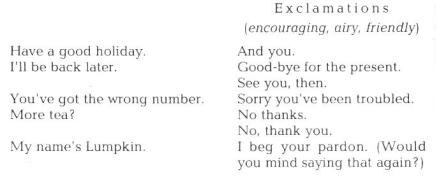
b) Listen to the replies and repeat them in the intervals. There is only one strongly stressed syllable in Model 3. The unstressed syllables should be pronounced on the level of the preceding stressed syllable. Do not forget to blend the words together. c) Listen to the verbal context and reply in the intervals.
4.In order to fix Intonation Pattern IV in your mind, ear and speech habits repeat the replies yourself until they sound perfectly natural to you. See that your Russian pronunciation habits do not interfere.
5.Listen to your fellow-student reading the replies given above. Tell him what his errors in the intonation are.
6.Listen to your teacher reading the verbal context below. Reply using one of the drill sentences. Pronounce it with Intonation Pattern IV. Say what attitude you mean to render:
221
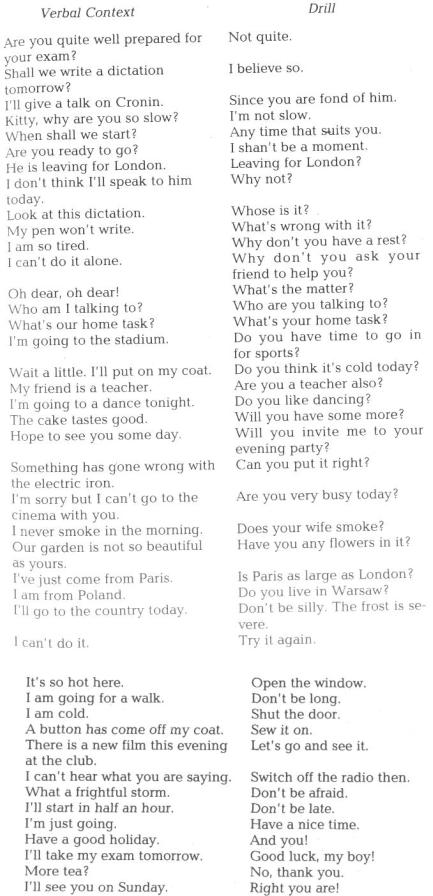
7.Say the same replies with Intonation Pattern II. Observe the difference in attitude.
8.Your teacher will suggest a verbal context. You in turn reply to it using Intonation Pattern IV. The drill will continue until every student has participated. Keep the exercise moving on rapidly.
M o d e l : My sister plays the piano very well.
222
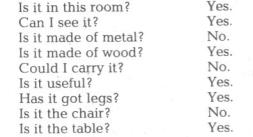
Does your 'brother 'play the 'piano too?
Wait a little. I'll lake my umbrella.
Is it /raining?
1.I've bought a new English book. 2. My friend is a student. 3. Something has gone wrong with my pen. 4. I am hungry. 5. My brother has a new flat. 6. I'd like to go to the Crimea next summer. 7. My mother is French.
8.I am fond of tennis. 9. I've just come from St.Petersburg. 10. I can't translate this article alone. 11. I don't think I'll finish this work today. 12. I am thirsty. 13. I am going to do the room. 14. I don't think she can speak English.
9.Translate into English. Use Intonation Pattern IV in the replies:
1. . - ? 2. . -
? 3. . - ? 4. - . -
? 5. . - ? 6. . -
?
10. Your teacher will suggest a verbal context. You in turn respond by using: a) statements, sounding not categoric, soothing, reassuring; b) special questions, expressing sympathy, interest, general questions, expressing interest; c) imperatives, soothing, encouraging, calmly patronising; d) exclamations, encouraging, airy, friendly.
11.** Listen to the dialogue "Guessing Game". Mark the stresses and tunes. Practise and memorize it:
12. Make up your own guessing game.
13.** Listen to the dialogues. Write them down. Mark the stresses and tunes. Practise and memorize them.
14. Read the following sentences. Observe correct pronunciation of rhythmic groups:
1. John came last night. 2. Don't do that here. 3. What nice soft gloves. 4. John's away on business. 5. Thank you for the letter. 6. They went for a walk in the Park. 7. At the bottom of Kensington Road. 8. At the bottom of Kenton Road. 9. At the bottom of Kent Road. 10. It wasn't so nice as before. 11. It wasn't so nice before. 12. It wasn't so nice then. 13. Come and see him off. 14. Don't be so impatient. 15. He always keeps me waiting. 16. It's the only time I'm free. 17. Would you mind passing the sugar? 18. Can you be here at eleven? 19. She's rather an impetuous woman. 20. Everyone else was on holiday. 21. How on earth can you manage to finish so quickly? 22. I sent them a photo of the children. 23. I should think it would be better to wait till tomorrow. 24. He realized that the bus wasn't going to stop for him.
15.*** This exercise is meant to develop your ability to hear and reproduce intonation. a) Listen to the text "Our Sitting-Room" sentence by sentence. Write it down. Mark the stresses and tunes. Practise the text. b) Record your reading. Play the recording back immediately for your teacher to detect the errors. Practise the text for test reading. c) Describe any picture in the same manner.
16.*** Read the text silently to make sure you understand each sentence. Split up each sentence into intonationgroups if necessary. Underline the communicative centre and the nuclear word in each phrase. Mark the stresses and tunes. It is not expected that each student of the class will mark the text in exactly the same way. Your teacher will help all the members of the class to correct their variants. Finally practise reading your corrected variant:
When you enter our sitting-room, the first thing you notice is the large window opposite the door. On the left
223

is an armchair with a small table by it. On the table are some books and an electric table-lamp. There are two other armchairs in the room and a settee.
"Aren't there any small chairs?"
"Only one, which is next to the radio-set, opposite the window. I have also a small cassette-recorder, which I keep in my bedroom."
"Have you many cassettes?"
"Quite a lot... The mantelpiece is on the right of the window and next to it is a bookcase." "Do you read a lot?"
"Yes, everybody in our family likes reading. There are books in every room." "What else is there in the room?" .
"Nothing else. We don't like a lot of things in our room."
Section Five
I. Accidental Rise
If the speaker wants to make one word of the descending head more prominent than the others he pronounces it a little higher than the preceding syllables thus breaking their descending succession. This nonfinal rise is called accidental. It never occurs on the first stressed syllable as this syllable is always the highest in the descending head.
Exercises
1. Listen carefully to the following sentences. Concentrate your attention on Accidental Rise:
1.In spring Nature awakens from her long winter sleep. 2. The trees are filled with new life. 3. The earth is warmed by the rays of the sun. 4. The weather gets gradually milder. 5. The fields and the meadows are covered with fresh green grass. 6. The woods and forests are filled with the songs of the birds. 7. When winter comes, we're obliged to spend more time indoors. 8. There's a bus stop just over there. 9. Then he has to take great care of the young animals. 10. I should say that football is one of the most popular sports in Great Britain. 11. He sat thinking of his own children. 12. The scientist is known all over the world. 13. Mary's umbrella is quite spoilt.
14.Ann was wearing a charming blue hat.
2.Listen to the same sentences and repeat them in the intervals. Make your voice go up a little on the word you want to make more prominent. Follow the intonation line exactly.
3.In order to fix the intonation of sentences with Accidental Rise in your mind, ear and speech habits repeat the sentences yourself until they sound perfectly natural to you.
4.Read the following sentences using Accidental Rise on the words in bold type. Do not forget to blend the words together:
1.I suppose it couldn't possibly happen again. 2. I'm sorry I couldn't quite make out what you were saying.
3.My husband often does the washing up for me. 4. We went for a day's walk in the forest in spite of the rain.
5.I'm reading a most interesting book by a new writer just now. 6. You have not given me a satisfactory explanation of your strange behaviour. 7. We hope to move into our new house before the month is out. 8. George plays football every Saturday afternoon. 9. I have an English lesson every day. 10. I haven't seen her for a long time. 11. The doctor says she must stay in bed for two or three days. 12. Tom Brown is the best pupil in his class.
II.Sequence of Tones
224
Alternative Questions
M o d e l : Has she a /niece | or a \nephew?
Alternative questions have the low-rising nuclear tone in the first intonation-group and the low-falling nuclear tone in the final intonation-group. The fall and the rise are of narrow range here.
Exercises
5. Listen carefully to the alternative questions. Concentrate your attention on the nuclear tones of both intonation-groups:
1.Are the bedrooms on the ground floor or on the first floor? 2. Is the furniture in his house modern or old?
3.Do the members of Dr. White's family read the Times or The Worker'? 4. Is it a large house or a small one? 5. Do you prefer tea or coffee? 6. Is your wife a housewife or does she work? 7. Shall I go on or stop here? 8. Does the dress fit you or do you want a larger one? 9. Have you a son or a daughter? 10. Do you study French or English?
6.Listen to the same sentences and repeat them in the intervals. Follow the intonation line of the model exactly.
7.In order to fix the intonation of alternative questions in your mind, ear and speech habits repeat the sentences yourself until they sound perfectly natural to you. Listen to your fellow-student reading the alternative questions. Tell him what his errors in the intonation are.
8.Complete the following sentences using the words in brackets:
1. Do you usually have dinner at home ...? (at the canteen) 2. Do you get up at six ...? (at seven o'clock) 3. Will you have clear soup ...? (cabbage soup) 4. How do you like your tea strong ...? (weak) 5. Do you do your morning exercises in the room ...? (the garden) 6. Does she study French ...? (English) 7. Do you usually have breakfast at eight ...? (nine) 8. Do you usually sit up late ...? (go to bed early) 9. Did it take you half an hour ...? (a quarter of an hour to get there) 10. Did you lay the table for 6 ...? (for 12 persons) 11. Did you take your exam in English on the 15th ...? (on the 17th of January) 12. Will you have black ...? (white coffee).
9. Make up alternative questions using the following sentences.
M o d e l : She is twenty. She is twenty-five.
Is she /twenty | or 'twenty-\five?
1. He lives in a new house. He lives in an old house. 2. Your children have milk in the morning. Your children have coffee in the morning. 3. He will have black coffee. He will have white coffee. 4. They spend Sundays in town. They spend Sundays in the country. 5. It is warm today. It is cold today. 6. She will go to the Caucasus next summer. She will go to the Crimea next summer. 7. Your friend speaks English. Your friend speaks Spanish. 8. Her nephew lives in Moscow. Her nephew lives in St. Petersburg.
10. Translate the following sentences:
1.? 2. ? 3.
? 4. ? 5.
? 6. ? 7.
? 8. ? 9.
? 10. , ? 11.
, ? 12. , ? 13.
?
11.Make up a dialogue using alternative questions. See that your Russian pronunciation habits do not interfere.
225
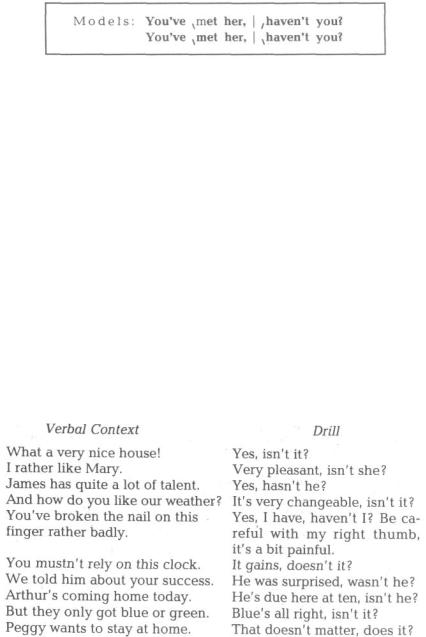
Disjunctive questions
Disjunctive questions consist of two intonation-groups. The sequence of tones in disjunctive questions depends on the attitude of the speaker towards the significance of the utterance.
The first intonation-group has generally the low-falling nuclear tone. The low-rising nuclear tone of the final intonation-group, or tag, shows that the speaker is not certain of the facts expressed in the first part of the question. An answer is expected.
e. g. I rang you up yesterday. You were meeting your \wife, | /weren't you? - Yes, I was.
The low-falling nuclear tone of the tag shows that the speaker is certain of the facts expressed in the first part of the question. No answer is expected.
e. g. I saw you at the station. You were meeting your \wife, | \weren't you? She looked so young and happy.
Exercises
12. a) Listen carefully to the following conversational situations. Concentrate your attention on the intonation of the replies:
b) Listen to the replies and repeat them in the intervals.
13.Listen to the verbal context and reply in the intervals.
14.In order to fix the intonation of disjunctive questions in your mind, ear and speech habits repeat the replies yourself until they sound perfectly natural to you.
15.Listen to a fellow-student reading the replies. Tell him what his errors in intonation are.
16.Read the drill sentences according to the given models. Observe the difference in meaning.
M o d e l s : The text is \easy, | /isn't it?
The text is \easy, | \isn't it?
1. She is better today, isn't she? 2. There is a lawn in front of your house, isn't there? 3. There are many new houses in your street, aren't there? 4. The New Year is the most favourite holiday in our country, isn't it? 5. Great Britain is an island, isn't it? 6. The Alps are higher than the Urals, aren't they? 7. The Mississippi is the longest river in the world, isn't it? 8. You don't speak Hungarian, do you? 9. You don't take beer, do you? 10.
226

You can't speak German yet, can you? 11. You have learned this poem by heart, haven't you? 12. You are fond of skating, aren't you? 13. We must pay right now, mustn't we? 14. They shouldn't be late, should they? 15. She can understand nearly everything, can't she? 16. It's my turn, isn't it?
17. Read the following conversational situations according to the models, suggested for replies. Concentrate your attention on the intonation of the replies. Say what meaning is rendered by them.
227
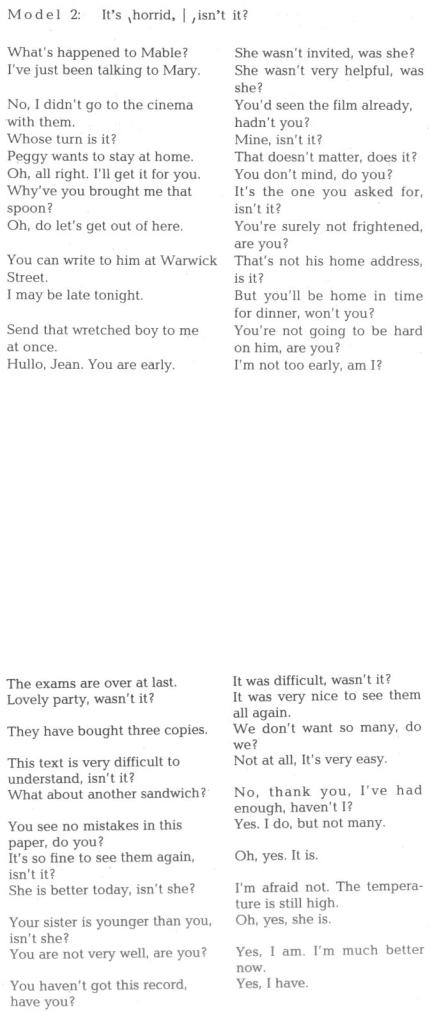
18. Complete the following sentences making them disjunctive questions. The speaker is not certain of the fact expressed in the first part of the sentence. An answer is expected. Concentrate your attention on the intonation of the tag:
I. You aren't reading this book now, ...? 2. She doesn't like tomatoes, ...? 3. He lives in Kiev, ...? 4. They usually have dinner at one o'clock, ...? 5. You like both pears and apples, ...? 6. He never uses pepper, ...? 7. It's high time to have a bite, ...? 8. Going out in such weather is out of the question, ...? 9. She is leaving for St.Petersburg, ...? 10. She can get rid of her mistakes, ...? 11. You finished school two years ago, ...? 12. You have passed your exams, ...? 13. You've got a letter, ...? 14. She hasn't finished school yet, ...?
19.Complete the same sentences. You are certain of the fact expressed in the first part of the sentence. No answer is expected. Observe the difference in the intonation of the tag.
20.Look through the exercise carefully. Mark the stresses and tunes. Read the tags of the disjunctive questions with the intonation suggested by the conversational situation:
228
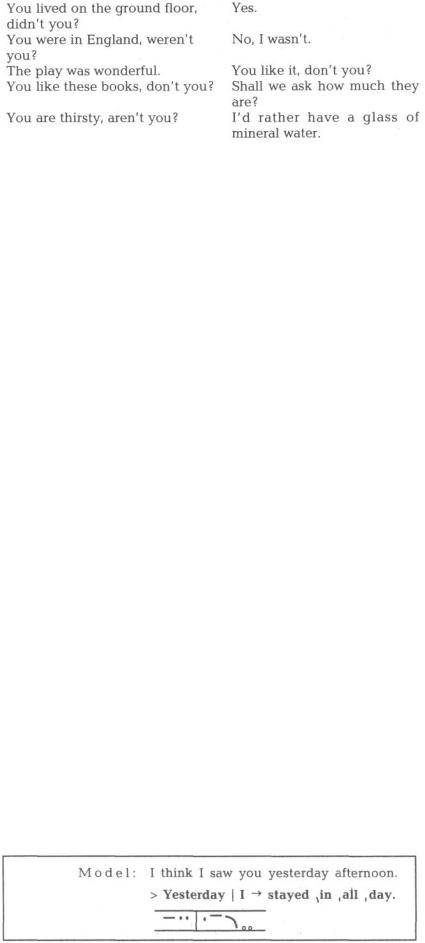
21.** Listen to the following dialogue. Mark the stresses and tunes. Practise and memorize it:
A:What a lovely day, isn't it?
B:Yes, it is.
A:How blue the sky looks, doesn't it?
B:Yes, it does.
A:What a lot of people, aren't there?
B:Yes, there are.
A:You're on holiday, aren't you?
B:Yes, I am.
A:It's a long one, isn't it?
B:Yes, it is.
A:You don't talk very much, do you?
B:No, I don't. You ask a lot of questions, don't you?
A:Yes, I do.
22.** Listen to the dialogue. Practise and memorize it.
23.Make up short dialogues with disjunctive questions.
24.This exercise is meant to develop your ability to reproduce the text with correct rhythm. Listen to the text. Split the text into intonation and rhythmic groups. Observe correct pronunciation of rhythmic groups. Practise the exercise:
The weather in England can change very quickly. One day last week I went for a walk in the country. When I started early in the morning the weather was beautiful. The sun was shining, the sky was blue and there were no clouds at all. In the middle of the morning a sudden change came. A cool wind started to blow, black clouds covered the sun and in a very short time it started to rain heavily. There were no houses in sight and I had no coat with me. So I got very wet indeed and very cold too. After about an hour I managed to catch a bus which took home. But when I arrived I was shivering and sneezing. Ar I've had a cold ever since. I ought to have taken my coat. we sometimes say that England is the only country where you ce have four seasons in one day.
Section Six
I. Intonation Pattern V
(Low pre-head + ) (descending head + ) mid-level (+ tail)
Stress-and-tone marks in the text: Mid-Level Tone: | > |.
The mid-level tone in the nucleus is pronounced on the medium level with any following tail syllables on the
229
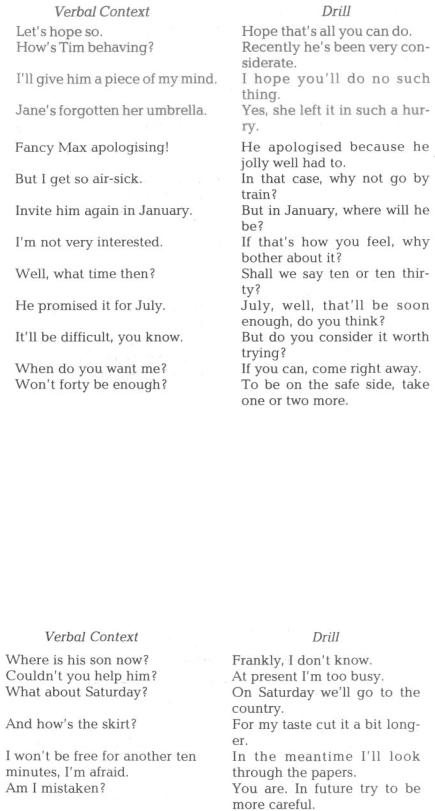
same level.
This intonation pattern is usually used in non-final intonation-groups expressing non-finality without any impression of expectancy.
Exercises
1. a)* Listen carefully to the following conversational situations. Concentrate your attention on the intonation of the non-final intonation-groups of the reply:
b) Listen carefully to the replies and repeat them in the intervals. Pronounce the nucleus and the tail of the nonfinal intonation-group on the same medium level of your voice. c) Listen to the verbal context and reply in the interval.
2.In order to fix Intonation Pattern V in your mind, ear and speech habits repeat the replies yourself until they sound perfectly natural to you.
3.Listen to a fellow-student reading the replies. Tell him what his errors in intonation are.
4.Your teacher will suggest a verbal context. You in turn respond to it by using mid-level nuclear tone in the non-final intonation-groups:
230
